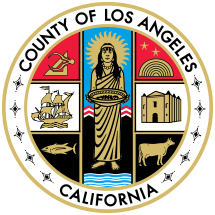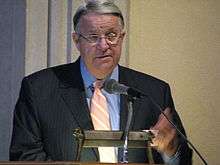Los Angeles County Board of Supervisors
| County of Los Angeles Board of Supervisors | |
|---|---|
 | |
| Type | |
| Type |
Unicameral board of Los Angeles County |
Term limits | 3 terms (12 years) |
| History | |
| Founded | 1852 |
| Preceded by | Court of Sessions |
| Leadership | |
Mayor and Supervisor, Fifth District |
Michael D. Antonovich Since 1980 |
Chair Pro Tempore and Supervisor, First District |
Hilda Solis Since 2014 |
Supervisor, Second District |
Mark Ridley-Thomas Since 2008 |
Supervisor, Third District |
Sheila Kuehl Since 2014 |
Supervisor, Fourth District |
Don Knabe Since 1996 |
| Structure | |
| Seats | 5 |
Length of term | 4 years |
| Elections | |
Last election | November 4, 2014 |
Next election | November 8, 2016 |
| Meeting place | |
|
Kenneth Hahn Hall of Administration Civic Center, Los Angeles, California | |
| Website | |
|
bos | |
| Constitution | |
| Charter of the County of Los Angeles | |
The Los Angeles County Board of Supervisors (LAC BOS) is the five-member governing body of Los Angeles County, California.
Membership
Members of the Board are officially nonpartisan, and are elected by constituents of their respective districts.[1] As of 2014, they are:
-

Hilda Solis
District 1
since 2014 -

Mark Ridley-Thomas
District 2
since 2008 -
.jpg)
Sheila Kuehl
District 3
since 2014 -

Don Knabe
District 4
since 1996 -

Michael D. Antonovich
District 5
since 1980
Elections
Supervisors are elected to four-year terms by a vote of Los Angeles County citizens who reside in the supervisorial district.[2] Supervisors must reside and be voters in the district they represent.[2] Elections for the First and Third Districts coincide with California's gubernatorial elections, while those for the Second, Fourth and Fifth districts coincide with the United States presidential election.[2] Supervisorial terms begin the first Monday in December after the election.
Term limits
To curb the powers of the five supervisors, Los Angeles County voters passed Measure B in March 2002 with a majority of 64%, to limit the supervisors to three consecutive four-year terms.[3] If a supervisor fills a vacancy, the unexpired term counts towards the term limit if there are more than two years (half the term) left to serve. The provisions are not retroactive, meaning that Michael Antonovich, currently the longest serving supervisor, could serve until 2016.
Supervisorial districts
Los Angeles County is divided into 5 supervisorial districts (SDs), with each Supervisor representing a district of approximately 2 million people.
Background
Los Angeles County follows usual California practice (which is similar to that of almost all other states) in that it did not subdivide into separate counties or increase the number of supervisors as its population soared after 1920. The only county with more than five supervisors is San Francisco, unique in California as it is legally both a city and a county, and no new counties have been formed since 1907 in the state. As a result, the concentration of local administrative power in each county supervisor is high; each one represents more than 2 million people. Moreover, because of the equal representation provisions of the Voting Rights Act, the supervisorial districts often make little geographical sense; in particular, Supervisor District 1 was specifically gerrymandered to be a majority-Latino area, while Supervisor District 2 was designed to have a plurality of African Americans. Despite the County's diverse population, the Board had lacked any Latino representation until 1991.
A local nickname some use for the Board is the "five little kings."[9] Unseating an incumbent supervisor is extraordinarily difficult, due largely to the prohibitive cost of mounting a successful challenge in districts of such enormous geographical and population size.
Like other elected officials, supervisors enjoy built-in advantages of incumbency. Supervisors routinely waive parking and rental fees for various organizations, provide bus trips and give free tickets to county facilities to constituents, and build projects for the community with the supervisor's name clearly marked. Each supervisor has a budget of $3,400,000 for staff and office expenses, with the remainder going into a "discretionary fund" that can be used for grants to non-profit agencies, without a vote by the other supervisors. "Good-government" advocates have long supported the idea of expanding Board membership to reduce the size of each district, and establishing an elected County Executive as a check and balance on the Board's power, but voters have rejected such proposals every time they have appeared on the ballot. However, former supervisor Gloria Molina supported expansion of the Board (to potentially increase Hispanic representation), and former supervisor Zev Yaroslavsky supported both Board expansion and the creation of an elected County Executive, much like in King County, Washington, where that officeholder directly supervises county departments.
The chair of the Board of Supervisors has the option of calling himself or herself mayor. The title has drawn criticism as it can lead to confusion with the mayor of the city of Los Angeles. However, those who support the use of the title say that all five members of the Board of Supervisors act as "mayors" or chief executives for the millions of people who live in unincorporated areas. Only Mike Antonovich used the "mayor" title when chairing the Board, primarily to represent and promote Los Angeles County when dealing with international diplomacy and trade. Otherwise, all other chairs have used the title chair, chairman, or chairwoman, depending on their preference.
Members of the Board of Supervisors also sit on the board of the Los Angeles County Metropolitan Transportation Authority, which is not a County agency.
Governance
Until recently, the Chief Executive Officer (currently Sachi Hamai[10]) was the appointed individual heading the county but had little power as supervisors retained the right to fire and hire department heads and often directly admonished department heads in public. Based on an ordinance authored by Supervisors Knabe and Yaroslavsky that took effect in April 2007, the CEO directly oversees departments on behalf of the supervisors, although the Los Angeles County Fire Department, Los Angeles County Sheriff's Department, Assessor, District Attorney, Auditor-Controller, and Executive Office of the Board of Supervisors continue to be under the direct purview of the Board of Supervisors. The change was made in response to several candidates either dropping out or declining to accept the position to replace former Chief Administrative Officer David Janssen. Antonovich was the lone supervisor to oppose the change, stating that such a move would lead to a more autocratic form of government and disenfranchise the 1.3 million who live in unincorporated areas.[11]
Board meetings
The Board meets every Tuesday at 9:30 a.m. at the Board Hearing Room (381B) at the Kenneth Hahn Hall of Administration in downtown Los Angeles.[12] On Tuesdays following a Monday holiday, Board meetings begin after lunch, at 1:00 p.m.[12]
Board meetings are conducted in accordance with Robert's Rules of Order, the Brown Act (California’s sunshine law), and the Rules of the Board. The Chief Executive Officer, the County Counsel and the Executive Officer, or their deputies, attend each Board meeting.[12]
The regular agendas for the first, second, third and fifth Tuesdays of the month are essentially a consent calendar, that is, all items are automatically approved without discussion, unless a Supervisor or member of the public requests discussion of a specific item.[12] The fourth Tuesday of the month is reserved for the purpose of conducting legally required public hearings, Board of Supervisors motions and department items continued from a previous meeting, have time constraints, or are critical in nature.[12] Since Board meetings are considered Brown Act bodies, a Board agenda is published 72 hours before the Board meeting is convened.
At the start of a meeting, after an invocation and the Pledge of Allegiance, all items that do not have "holds" placed on them by a Supervisor or a member of the public, or are mandatory public hearings, are approved on a consent calendar.[12] Following that, presentations of various dignitaries (e.g., local consulate officials, awards to County employees and the general public, and pets for adoption) are made.[12] Then, items that were not approved are called in numerical order unless a supervisor wishes to take items out of order.[12]
Members of the public are allotted three minutes to make public comment on all the agenda items that they intend to discuss.[12] An additional three minutes are provided during general public comment on any topic within the board's jurisdiction.[12] Individuals must submit comment cards before the start of the meeting and wait until their item is called. On popular topics with multiple speakers, comments may be restricted to as little as one minute each, and the board has the discretion to figuratively muzzle anyone who is addressing the board in a disruptive manner.[12]
Weekly Board meetings are broadcast live online and televised on local public television (KLCS Channel 58). Transcripts and statements of proceedings are published online.[12] However, because some Board decisions have major implications, speakers and protesters on behalf of many causes regularly attend the meetings. The county is sued frequently by various public interest law firms and organizations on behalf of people who disagree with the Board's decisions.
References
- ↑ Sewell, Abby (3 April 2016). "This year's election could usher in liberal 'supermajority' on L.A. County supervisors board". Los Angeles Times. Retrieved 31 October 2016.
- 1 2 3 "Charter of the County of Los Angeles" (PDF). Board of Supervisors. County of Los Angeles. June 2006. Retrieved 10 September 2013.
- ↑ "Directory of Los Angeles County, CA Measures - March 5, 2002 Election". League of Women Voters of California Education Fund. 19 April 2002. Retrieved 10 September 2013.
- ↑ "First Supervisorial District Map" (PDF). Chief Executive Office. County of Los Angeles. January 2012. Retrieved 10 September 2013.
- ↑ "Second Supervisorial District Map" (PDF). Chief Executive Office. County of Los Angeles. January 2012. Retrieved 10 September 2013.
- ↑ "Third Supervisorial District Map" (PDF). Chief Executive Office. County of Los Angeles. January 2012. Retrieved 10 September 2013.
- ↑ "Fourth Supervisorial District Map" (PDF). Chief Executive Office. County of Los Angeles. January 2012. Retrieved 10 September 2013.
- ↑ "Fifth Supervisorial District Map" (PDF). Chief Executive Office. County of Los Angeles. January 2012. Retrieved 10 September 2013.
- ↑ Niki Cervantes, "Five little kings' power at stake in redistricting suit; Proposed changes would clip clout of L.A. supervisors," San Diego Union-Tribune, 10 May 1990, A3.
- ↑
- ↑ Power Shift Means Less Accountability, More Bureaucracy
- 1 2 3 4 5 6 7 8 9 10 11 12 "Information Regarding Agendas and Meetings of the Board of Supervisors". Executive Office. County of Los Angeles. Retrieved 10 September 2013.